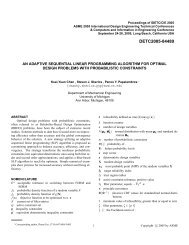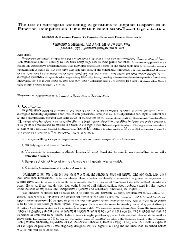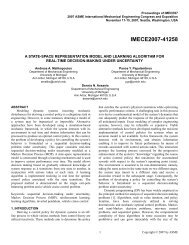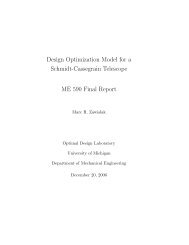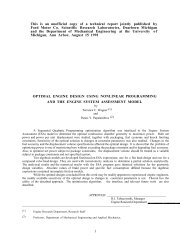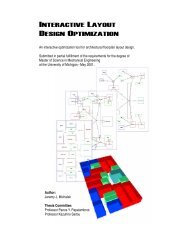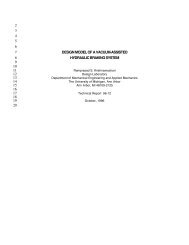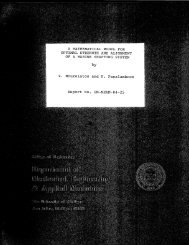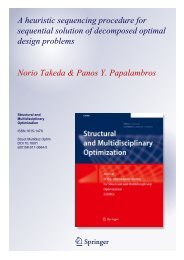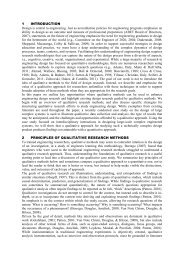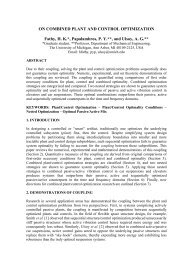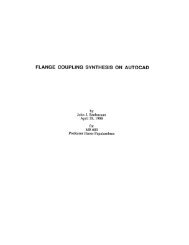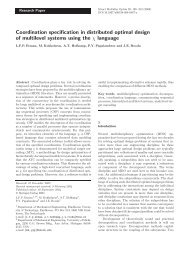Decomposition Analysis of an Automotive Powertrain Design ...
Decomposition Analysis of an Automotive Powertrain Design ...
Decomposition Analysis of an Automotive Powertrain Design ...
You also want an ePaper? Increase the reach of your titles
YUMPU automatically turns print PDFs into web optimized ePapers that Google loves.
τ dV<br />
τ 0-60 = τ :⌡ ⌠ dt dt = 60 mph; initial conditions: V o = 0 (68)<br />
0<br />
τ<br />
τ 5-20 = τ :⌡ ⌠ 0<br />
dV<br />
dt dt = 20 mph; initial conditions: V o = 5 mph (69)<br />
4<br />
S 0-4 = ⌡ ⌠ 0<br />
4<br />
( ⌡ ⌠ 0<br />
dV<br />
dt dt ) dt ; initial conditions: V o = 0. (70)<br />
Computationally, each integral is discretized into sums where the integr<strong>an</strong>d is computed for each<br />
discrete time interval, ∆t i . For decompositon <strong>an</strong>alysis, ∆t i c<strong>an</strong> be viewed as a state variable, <strong>an</strong>d in<br />
the original formulation <strong>of</strong> this problem (Wagner 1993) it was considered in the FDT. However,<br />
in the final implementation <strong>of</strong> a numerical integration scheme, it becomes a parameter in the sense<br />
that it is prescribed by the integration scheme, <strong>an</strong>d hence neglected in the construction <strong>of</strong> the FDT.<br />
This treatment <strong>of</strong> the time parameter, makes partitioning results obtained with heuristic search<br />
methods directly comparable to those obtained with global search methods.<br />
The gradeability criteria are defined by steady-state formulations <strong>of</strong> the equations <strong>of</strong><br />
motion. Rearr<strong>an</strong>gement yields the following expressions<br />
<strong>an</strong>d<br />
sin α s = (T e (60 ξ fd ξ 1 V s /(2 r e π)) ξ fd ξ 1 η fd η gb R to - r e (F roll + F aero )) (r e M g) -1 (71)<br />
sin (α c ) = (T e (60 ξ fd ξ ngears-1 V c /(2 r e π)) ξ fd ξ ngears-1 η fd η gb - r e (F roll + F aero )) (r e M g) -1<br />
(72)<br />
where, α c = 3.43 o (6% grade) <strong>an</strong>d V s = 5 mph.<br />
Equations (1) through (72) define the functional relationships among the variables<br />
describing the system. Formulation <strong>of</strong> the optimal design problem by identifying objective function<br />
<strong>an</strong>d constraints follows.<br />
The objective is to develop a vehicle that competes in a given market, meets emissions<br />
requirements, <strong>an</strong>d has the maximum fuel economy possible. Target acceleration characteristics are<br />
specified to deem it competitive in its market. The U.S. Federal Cle<strong>an</strong> Air Act constrains the NOx<br />
emissions to no more th<strong>an</strong> 0.4 g/mile; time to accelerate from 0 to 60 mph is no greater th<strong>an</strong> the



